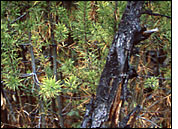 Fires
play an important role in the natural changes that occur in Earth's
ecosystems. The diversity of plant and animal life in the world's
forests, prairies, and wetlands is (partly) dependent on the effects of
fire; in fact, some plants cannot reproduce without fire (fire breaks
open the outside coating of some seeds and stimulates germination). What
may at first look like total devastation soon becomes a panorama of new
life. Fire initiates critical natural processes by breaking down organic
matter into soil nutrients. Rain then moves these nutrients back into
the soil providing a rejuvenated fertile seedbed for plants. With less
competition and more sunlight, seedlings grow more quickly. Fires
play an important role in the natural changes that occur in Earth's
ecosystems. The diversity of plant and animal life in the world's
forests, prairies, and wetlands is (partly) dependent on the effects of
fire; in fact, some plants cannot reproduce without fire (fire breaks
open the outside coating of some seeds and stimulates germination). What
may at first look like total devastation soon becomes a panorama of new
life. Fire initiates critical natural processes by breaking down organic
matter into soil nutrients. Rain then moves these nutrients back into
the soil providing a rejuvenated fertile seedbed for plants. With less
competition and more sunlight, seedlings grow more quickly.
Wild animals deal with fire remarkably well. Birds fly out of the
fire area, large animals leave the danger zone by escaping to ponds and
streams, while others return to their burrows. Usually few animals are
killed by fire.
Prescribed fire is one of the most important tools used today to
manage Earth's diverse ecosystems. A scientific prescription, prescribed
fires help create a mosaic of diverse habitats for plants and animals.
If all fire is suppressed, fuel (grasses, needles, leaves, brush, and
fallen trees) can build up and allow larger, and sometimes
uncontrollable, fires to occur. If enough fuel builds up, the fires could
be so intense that they may destroy the seeds in the soil and hinder new
tree and plant growth. By burning away accumulated fuels, planned fires
make landscapes safer for future natural fires.
State of the Science
By 1990, global tropical deforestation was occurring at a
rate of about 1.8 percent of the world's total forest lands per year.
Approximately 142,000 square kilometers of rainforest are eliminated
annually—an area slightly larger than the state of Arkansas (more information on this topic can
be found in the Tropical Deforestation Fact Sheet). Using data
from satellite sensors, aircraft, and ground-based initiatives,
scientists are working to develop a new global fire monitoring program
that will enable them to better understand the myriad implications of
this growing problem. Specifically, efforts are underway to quantify the
total area of forests and grass land burned each year and to more
precisely estimate the amount of resulting emission products. These
newer and better data will facilitate development of more robust
computer models that will enhance scientists' abilities to predict how
biomass burning will impact climate, the environment, and air quality.
next: Trace Gases Emissions
back: Introduction
|
|

Global Fire Monitoring
Introduction
Why are Fire Important?
Trace Gases Emissions
Aerosol Emissions
NASA and NOAA Missions for Monitoring Global Fires
Related Case Studies
Evolving in the Presence of Fire
A Burning Question
Fire!
Related Data Sets
1km2 AVHRR Fires
4km2 TRMM Fires
Top Left: Burned vegetation quickly releases nutrients back into the soil,
nurturing the rapid growth of new vegetation. These jack pine seedlings germinated after
a fire softened pinecones littering the forest floor, releasing the seeds they held.
(Photograph courtesy Forrest Hall, NASA GSFC/University of Maryland) |


